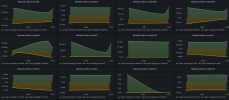Every so often (like right now), I'll start seeing a lot of KNET logs about a link going down and coming back up. Sometimes rebooting one node will fix it, sometimes it won't. It seems to happen randomly after node reboots or some other event. How can I determine which node is causing this or what part of the infrastructure is causing it?
I have 2 10GbE interfaces and 2 GbE interfaces LAGd together on each host except one, which also has 2 10GbE but 4 GbE all lagged together. Each logical interface trunks several VLANs.
1 of the 10GbE VLANs contains the main corosync network as well as the Ceph front side network. The other 10GbE VLAN contains the secondary corosync ring and the Ceph back side network. Each 10GbE link is connected via DAC to a different switch. Here's the logs I see on each node:
Here's my corosync.conf:
Here's a graph of traffic from the switches over the last 15 minutes (ignore the vertical lines):

Ring 0 is the "Private" network and Ring 1 is the "Secondary" network, which shares a VLAN with the "Storage" network. It looks like it's Ring 1 that's flapping...but why?
I have 2 10GbE interfaces and 2 GbE interfaces LAGd together on each host except one, which also has 2 10GbE but 4 GbE all lagged together. Each logical interface trunks several VLANs.
1 of the 10GbE VLANs contains the main corosync network as well as the Ceph front side network. The other 10GbE VLAN contains the secondary corosync ring and the Ceph back side network. Each 10GbE link is connected via DAC to a different switch. Here's the logs I see on each node:
Code:
Jan 24 20:23:31 pve2 corosync[6080]: [KNET ] link: host: 5 link: 1 is down
Jan 24 20:23:31 pve2 corosync[6080]: [KNET ] host: host: 5 (passive) best link: 0 (pri: 1)
Jan 24 20:23:34 pve2 corosync[6080]: [KNET ] rx: host: 5 link: 1 is up
Jan 24 20:23:34 pve2 corosync[6080]: [KNET ] link: Resetting MTU for link 1 because host 5 joined
Jan 24 20:23:34 pve2 corosync[6080]: [KNET ] host: host: 5 (passive) best link: 0 (pri: 1)
Jan 24 20:23:34 pve2 corosync[6080]: [KNET ] pmtud: Global data MTU changed to: 1397Here's my corosync.conf:
Code:
logging {
debug: off
to_syslog: yes
}
nodelist {
node {
name: pve1
nodeid: 4
quorum_votes: 1
ring0_addr: 10.10.0.32
ring1_addr: 10.13.1.4
}
node {
name: pve2
nodeid: 1
quorum_votes: 1
ring0_addr: 10.10.0.1
ring1_addr: 10.13.1.1
}
node {
name: pve3
nodeid: 3
quorum_votes: 1
ring0_addr: 10.10.0.2
ring1_addr: 10.13.1.2
}
node {
name: pve4
nodeid: 2
quorum_votes: 1
ring0_addr: 10.10.0.3
ring1_addr: 10.13.1.3
}
node {
name: pve5
nodeid: 5
quorum_votes: 1
ring0_addr: 10.10.0.20
ring1_addr: 10.13.1.5
}
}
quorum {
provider: corosync_votequorum
}
totem {
cluster_name: PVE
config_version: 6
interface {
bindnetaddr: 10.10.0.1
ringnumber: 0
}
interface {
bindnetaddr: 10.13.1.1
ringnumber: 1
}
ip_version: ipv4
rrp_mode: passive
secauth: on
version: 2
}Here's a graph of traffic from the switches over the last 15 minutes (ignore the vertical lines):

Ring 0 is the "Private" network and Ring 1 is the "Secondary" network, which shares a VLAN with the "Storage" network. It looks like it's Ring 1 that's flapping...but why?
Last edited:










